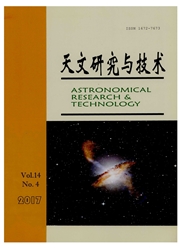

 中文摘要:
中文摘要:
嫦娥三号成功软着陆后,中国VLBI网(Chinese VLBI Network,CVN)利用同波束VLBI技术(Same-Beam VLBI,SBI)观测巡视器玉兔和着陆器。分析了嫦娥三号同波束VLBI技术技术,发现电离层差分时延导致差分相时延趋势变化;分析了同波束VLBI技术差分相时延(Differential Phase Delay,DPD)多项式拟合后残差,发现巡视器发射数传信号和遥测信号条件下差分相时延残差的随机误差分别为0.085 ps和0.192 ps,导致遥测信号差分相时延随机误差大的原因是巡视器全向天线基准信号稳定度太低;给出了差分相时延闭合时延结果,与定位解算结果保持一致,说明整周模糊度解算成功;然后分析相对定位后的差分相时延残差,分析发现巡视器发射数传信号时,残差约为0.05 mm,发射遥测信号时,残差为0.2~0.7 mm。最后确定嫦娥三号差分相时延误差因素主要为整周模糊度、电离层差分时延和巡视器天线基准信号频率稳定度太低导致的。
 英文摘要:
英文摘要:
After its successful soft landing, Chinese VLBI Network has been observing Chang'E-3 Rover and Lander by using Same-Beam VLBI technique. In this paper, we present a research on the residuals of DPD after eighth-order polynomial fitting. Its random error is 0. 085 picosecond (ps) as Rover transmits data and O. 192ps when rover launches telemetry signal. We also acquire closure delay of DPD; it almost equals to the systematic error that computes during determination, which implies that cycle ambiguity of DPD can be successfully determined. We also analyze the residuals obtained after relative position determination, and find that RMS is around 0. 2-0. 7mm when the rover transmits telemetry signal, and is about 0. 05mm while rover transmits data. Based on the analysis of DPD residuals, we conclude that the system error of DPD has three main issues affecting its performance, including the bias of cycle ambiguity, the differential delay of ionospheric and the noise which is caused by the reference signal with low frequent stability.
 同期刊论文项目
同期刊论文项目
 同项目期刊论文
同项目期刊论文
 Relative position determination of a lunar rover using the biased differential phase delay of same-b
Relative position determination of a lunar rover using the biased differential phase delay of same-b 期刊信息
期刊信息
